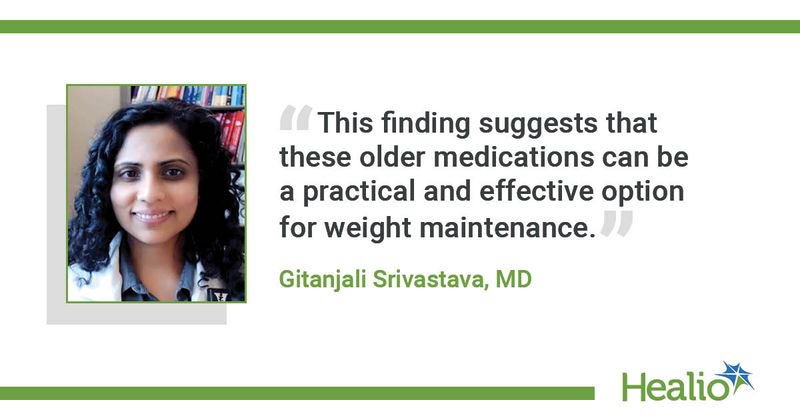Older, cost-effective anti-obesity medications maintain weight loss after GLP-1 therapy
Key takeaways:
- Participants who switched to older anti-obesity drugs after GLP-1 therapy lost about 25% of their weight from baseline, researchers found.
- Participants mostly received metformin following GLP-1s.
Participants enrolled in a GLP-1 receptor agonist weight-loss program maintained their weight loss at long-term follow-up after transitioning to older-generation, generic anti-obesity medications, researchers reported in Obesity.
“Given the high cost and limited access to GLP-1 receptor agonists, we will consider recommending older-generation anti-obesity medications as a cost-effective strategy for patients who have successfully lost weight with GLP-1 receptor agonists but face financial or access barriers,” Gitanjali Srivastava, MD, medical director of obesity medicine and professor of medicine at the Vanderbilt University School of Medicine, told Healio.

GLP-1 receptor agonists are a novel, effective treatment for overweight/obesity, but can be expensive and inconsistently available, according to the researchers. Additionally, previous research shows that after patients stop using GLP-1 receptor agonists, they may regain the weight they lost.
The researchers performed this prospective real-world cohort study to examine whether participants who took GLP-1 receptor agonists for 1 year as part of a weight management program could sustain their weight loss after transitioning to more affordable second-generation anti-obesity medications, including metformin, topiramate, phentermine, bupropion and/or naltrexone.
The cohort comprised 105 participants (mean age, 45.2 years; 92.1% women; 80.6% white; mean BMI, 36.4 kg/m2) enrolled in an 18-month “medical weight loss bundle” program, initiated by Vanderbilt University Medical Center, who achieved a BMI less than 30 kg/m2 after 1 year of anti-obesity medication treatment followed by 6 months of transition care. The researchers measured body weight outcomes at 6-, 12-, 18- and 24-month follow-up.
Of the cohort, 69 participants completed 12 months of therapy with a GLP-1 receptor agonist, namely semaglutide (Wegovy/Ozempic, Novo Nordisk) 2 mg per week (71%) or 2.4 mg per week (49%). Forty participants then transitioned to older-generation, generic weight-loss drugs at 12 months for weight maintenance. Most received extended-release metformin (80%), followed by topiramate (32.5%) and bupropion (32.5%). At 1 year, the group had a mean BMI of 27.9 kg/m2 and had lost approximately 18.3% (95% CI, 13-23.6) of their body weight from baseline. This mean BMI persisted at 18-month follow-up, showing that weight loss was maintained.
At follow-up visits conducted 1.5 months later, on average, the researchers found that average BMI for this subgroup was 27.2 kg/m2 (95% CI, 26.3-28.1), representing a mean total weight reduction of 25.5% (95% CI, 23.1-27.9).
Finally, mean BMI for this group did not appear statistically significantly different between follow-up at 12 months, 18 months, 1.5 months thereafter and 24 months, suggesting that participants who transitioned to generic, older-generation anti-obesity medications at 1 year were able to maintain their weight loss, according to the researchers.
The researchers noted several limitations to this study, including a lack of diversity in the cohort and the possibility that some patients may have continued taking GLP-1 receptor agonists beyond the 12-month mark.
The researchers were “pleasantly surprised” by these results, Srivastava said.
“While we hypothesized that older anti-obesity medications could help maintain weight loss, the extent to which patients were able to sustain and even further reduce their weight was unexpected,” she told Healio. “This finding suggests that these older medications can be a practical and effective option for weight maintenance.
“While our study shows promising results, it is crucial for patients to work closely with their health care providers to determine the best treatment plan for their individual needs,” Srivastava said.
For more information:
Gitanjali Srivastava, MD, can be reached at gitanjali.srivastava@vumc.org.
